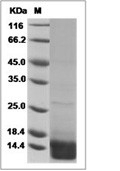购物车
- 全部删除
 您的购物车当前为空
您的购物车当前为空

CXCL14 Protein, Mouse, Recombinant is expressed in E. coli expression system. The predicted molecular weight is 9.4 kDa and the accession number is Q9WUQ5.

| 规格 | 价格 | 库存 | 数量 |
|---|---|---|---|
| 20 μg | ¥ 1,050 | 现货 | |
| 100 μg | ¥ 2,940 | 5日内发货 | |
| 1 mg | ¥ 19,100 | 5日内发货 |
| 生物活性 | Activity testing is in progress. It is theoretically active, but we cannot guarantee it. If you require protein activity, we recommend choosing the eukaryotic expression version first. |
| 产品描述 | CXCL14 Protein, Mouse, Recombinant is expressed in E. coli expression system. The predicted molecular weight is 9.4 kDa and the accession number is Q9WUQ5. |
| 种属 | Mouse |
| 表达系统 | E. coli |
| 标签 | Tag Free |
| 蛋白编号 | Q9WUQ5 |
| 别名 | Scyb14,NJAC,MIP2γ,MIP2gamma,MIP-2g,KS1,Kec,chemokine (C-X-C motif) ligand 14,BRAK,bolekine,BMAC,AI414372,1200006I23Rik,1110031L23Rik |
| 蛋白构建 | A DNA sequence encoding the mouse Cxcl14 (NP_062514.2) (Ser23-Glu99) was expressed. Predicted N terminal: Ser 23 |
| 蛋白纯度 | > 95 % as determined by SDS-PAGE.  |
| 分子量 | 9.4 kDa (predicted) |
| 内毒素 | Please contact us for more information. |
| 缓冲液 | Lyophilized from a solution filtered through a 0.22 μm filter, containing 100 mM Na2HPO4, 1 M NaCl, pH 6. 5. Typically, a mixture containing 5% to 8% trehalose, mannitol, and 0.01% Tween 80 is incorporated as a protective agent before lyophilization. |
| 复溶方法 | A Certificate of Analysis (CoA) containing reconstitution instructions is included with the products. Please refer to the CoA for detailed information. |
| 存储 | It is recommended to store recombinant proteins at -20°C to -80°C for future use. Lyophilized powders can be stably stored for over 12 months, while liquid products can be stored for 6-12 months at -80°C. For reconstituted protein solutions, the solution can be stored at -20°C to -80°C for at least 3 months. Please avoid multiple freeze-thaw cycles and store products in aliquots. |
| 运输方式 | In general, Lyophilized powders are shipping with blue ice. |
| 研究背景 | CXCL14 is a CXC chemokine family that exhibits antimicrobial activity and contains an amphipathic cationic alpha-helical region in the C-terminus, a characteristic structure of antimicrobial peptides (AMPs). CXCL14 is involved in cell recruitment, migration, activation, and homing in liver diseases and have been shown to be upregulated during acute liver injury in animal models. The CXC chemokine ligand 14 (CXCL14) had been show highly expressed in tumor-associated stromal cells, promoting tumor cell growth, and invasion. The stimulation of dysregulated CXCL14 expression by P. gingivalis may help promote dysbiosis and the development of chronic periodontitis. The level of CXCL14 expression may be a valuable adjuvant parameter to predict the prognosis of patients with oral carcinoma and may be a potential therapeutic target. |